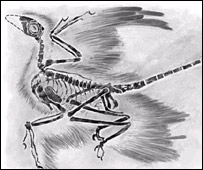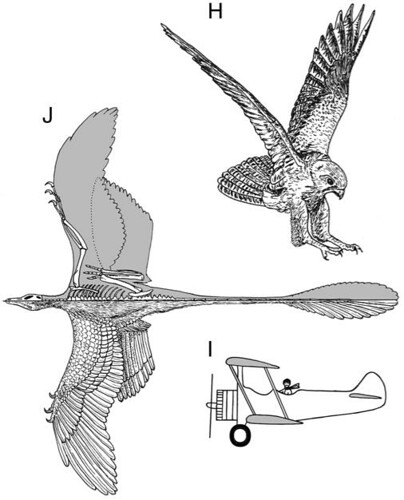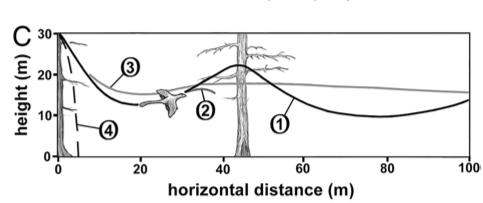The ancestors of modern birds are thought to have been small, feathered, dinosaurs, the theropods. One of these small feathered dinosaurs is Microraptor gui, a feathered dromaosaur that lived 125 million years ago in what is now China. According to the evidence, Microraptor gui was one of the earliest gliders. But unlike modern birds, it appears to have utilized four wings, like a biplane, because it had long and asymmetric flight feathers on both its hands and feet.
According to initial interpretations, Microraptor flew with its legs spread out laterally, such that its four wings were configured like a dragonfly's wings. However, upon further study, Sankar Chatterjee and R Jack Templin offer an alternative hypothesis for early avian flight that is consistent with limb and feather orientation such that it produced lift while preserving a normal theropod flight posture (see below).
They propose that the "Z-conformation"; with the hindlimbs tilted upward, slightly behind the forelimbs, and the tail tilted upward to control pitch (D, below) produces the most lift and the least drag. They also compare the aerodynamics of a cylindrical tibio-tarsus versus a tibio-tarsus with caudal feathers, revealing that the feathered tibio-tarsus produces less drag (E, F, G, below).
"We had no other choice but to go for the bi-plane configuration," said Chatterjee.
Chatterjee and Templin point out that the tibio-tarsus aerodynamics of a gliding Microraptor are similar to a modern day raptor pouncing on prey from the air and carrying it (H, below).
They then compare Microraptor to a typical staggered biplane of the 1920s, noting that the biplane aircraft had a large additional drag due to wires, struts, etc. between the two wings, which eventually made the biplane obsolete except for a niche application; whereas such drag-induced structures were absent in Microraptor. Life reconstruction of the M. gui (IVPP V13352) in a dorsal view showing the morphology and distribution of hindlimb feathers (J; left side) and orientation of the hindlimb (J; right side) during gliding.
Using this anatomical model, the evidence indicates that Microraptor was not capable of ground or running takeoff, because it lacked the supracoracoideus ("wishbone") pulley to elevate its wings. Moreover, running takeoff would damage its ventral metatarsal wings. Instead, Chatterjee and Templin show how Microraptor efficiently glided between perches that could have been 40 meters distant using phugoid gliding (curve 1, below).
This research also sheds light on a contentious debate over the evolution of bird flight. Some researchers argue that this evolutionary development occurred from the ground up (the "cursorial model"). Others contend that small, feathered dinosaurs were already living in treetops and developed flight in order to get from one tree to another (the "trees down model").
Chatterjee and Templin favor the "trees down" model.
Alternatively, this biplane-phase of flight, the first time it has ever been seen in nature, could just represent a failed evolutionary experiment.
This study appears in the peer-reviewed journal, Proceedings of the National Academy of Sciences.
Sources
Biplane wing planform and flight performance of the feathered dinosaur Microraptor gui, by Sankar Chatterjee and R. Jack Templin Proceedings of the National Academy of Sciences (doi:10.1073/pnas.0609975104) [PDF]
Contributing story.
- Log in to post comments





I always thought that WWI biplanes were the coolest looking things, and used to build models of tme as a kid, so I guess I got to get me one of them VERY Cool Microraptor gui's! Any chance they come in red?
HI:
You can get one in reddish-orange.
Is there any reason why flight could not have evolved from both the ground up and the trees down models? There are so many examples of covergent evolution extant today...why could flight have not emerged from a "neutral" animal that had the capacity to develop feathers or already had feathers that also filled several niches in various forms ...and so evolved the specific patterns of the feathers in each niche?
Sort of like how all the colors and aspects of humans are thought to have evolved from a medium brown, medium build human in Africa.
When I look at the various reconstructions of the early birdlike animals/birds, I think...how could a running/walking or climbing animal have developed flight or feather-assisted gliding in that particular way...running/bounding. climbing/gliding, etc...and when I look at this microraptor, I see a jumping/folding action. Sounds plausible and it works easily (i.e you don't have to stretch or twist your imagination much to see it heppen in a real-world way)...or at least it makes sense in my little imagination.
I really enjoy this subject. Thanks! :)
Do you think that the study of birds seems to have started to be taken "seriously" when the strong link was made between birds and dinosaurs - that birds are living dinosaurs? It seems that way to me.
Clapping
Chardyspal
Is it just my PC or does this essay appear WAY at the bottom of alot of blank space? Probably just me...
Chardyspal
Wow, neat!
It sounds to me like its flying habits were similar to a flying squirrel's, which might be a useful comparison for working out how it evolved.
Bob
...And climbing a tree wouldn't damage the ventral metatarsal wings?
Taking Wing, by Pat Shipman is a good discussion of this subject.